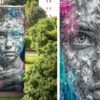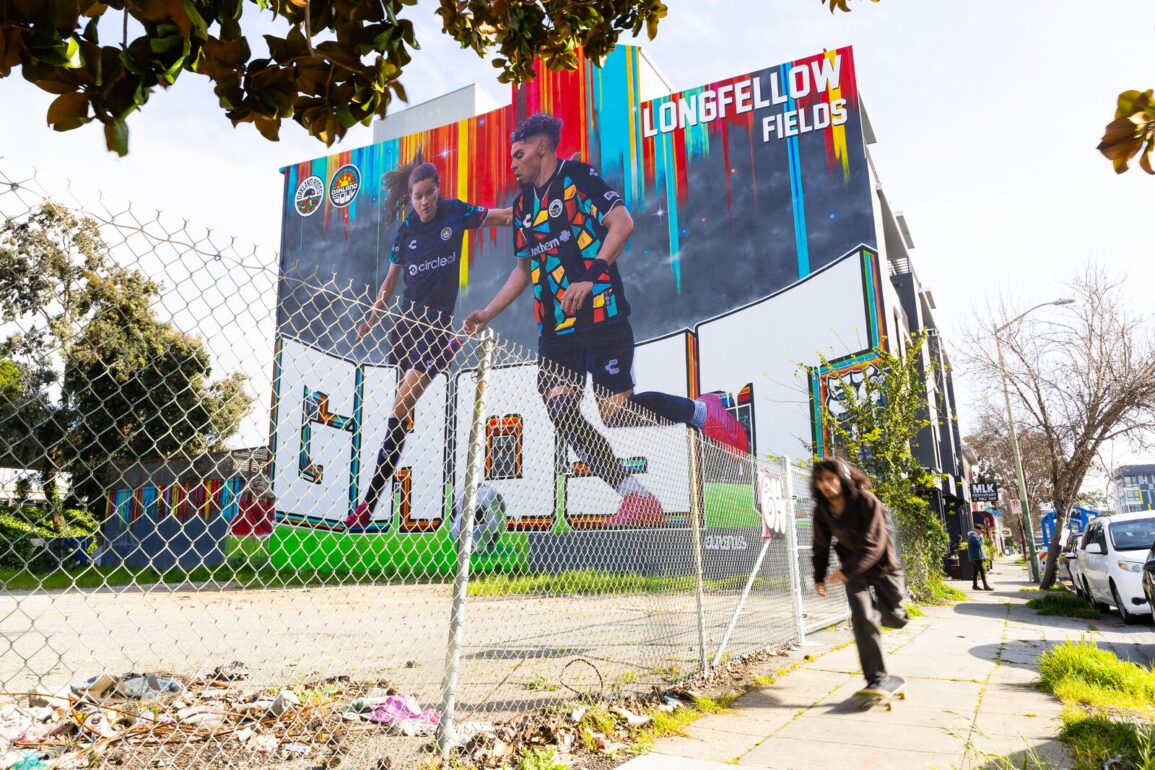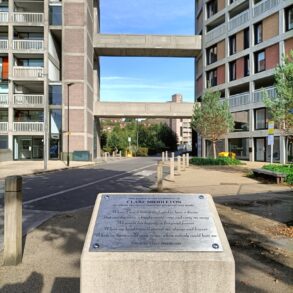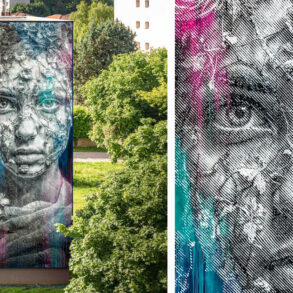Looming over the MacArthur BART station, close to where I-580 meets Highway 24, the larger-than-life images of two soccer players defend the Oakland skyline. The mural depicts Oakland Roots and Soul stars Johnny Rodriguez and Sam Tran, along with a tribute to graffiti legend Ghost51. It’s part of the incoming Longfellow Fields project, a pair of community soccer fields set to open later this year at Martin Luther King Jr. Way and 39th Street, next door to one of the country’s oldest independent Black bookstores, Marcus Books.
The project was conceived last year when Paulo Esperon and Lauren Silverman, longtime Oakland residents, saw a stark absence of soccer fields in the area. The two took it upon themselves to address this absence head on. They connected with the Oakland Roots and Soul Sports Club through cofounder Edreece Arghandiwal, who from the beginning saw the Roots as a way to give back to Oakland.
The pair’s ideas aligned with the club’s “passions for wanting to see safe spaces,” Arghandiwal said. “They reached out and said, Hey, there’s this little lot that’s adjacent to this building, and it’s pretty level. We think we can convert it to a mini soccer field. This could be a really cool cultural hub for future youth to have access and to build programming around.”
Born and raised in the Town, Arghandiwal, himself a former soccer player, recalled a childhood of playing on torn-up fields in underresourced leagues. Upon graduating, he returned to Oakland and started spinning the web of connections that would lead to the creation of a professional soccer team. But for Arghandiwal, the club was always a vehicle for a larger vision of social transformation and community care. This vision lives on in everything from the ownership structure of the Roots and Soul — fans in the community own shares of the organization — to the teams’ aesthetic. All over Oakland, people wear Roots and Soul merchandise, many of them surely unaware of the teams they’re supporting, as Arghandiwal acknowledged with a chuckle, but wanting to rep a sense of place anyway.
A sense of place. That’s a fraught subject in the Longfellow neighborhood, which has been defined in recent years by displacement. The 2008 financial crisis was experienced here, in disinvested Longfellow, as a foreclosure crisis. As a result, Black families were forced out, and Black businesses were shuttered. A neighborhood that was 51 percent Black in 2010 was 30 percent Black by 2020. With the field and mural project, the Roots and Soul club stepped right into the middle of this cultural rupture in a changing North Oakland, kickstarting a very Oakland tale of community cocreation, conflict resolution, and the bridging of worlds that otherwise stand apart.
A tribute to Ghost51
The mural began as a site of tension. The location for a field had been chosen, and the wall had been confirmed, and Arghandiwal was now working with Hungry Ghost Productions, whose artists comprise the likes of founder David Burke, Pancho Pescador, and Joevic Yeban — well-known figures in the Oakland mural scene. Importantly, the group represented Filipino, Black, LGBTQ+, immigrant, and Indigenous communities.
But when the artists arrived on the site, they found that the 60-foot façade was no empty canvas — and certainly not an “untouched area,” as the club’s website puts it. Along with the tents pitched by unhoused people lining the periphery of the lot was a tribute graffiti piece that simply said “RIP GHOST” in bold baby-pink letters, signed by the CK crew. This was a memorial to Ghost51, aka Farida Kohgadai, a prolific painter and beloved Bay Area community member. She had died in 2022 at 35 years old, leaving behind a newborn daughter and newlywed spouse.
Kohgadai was known for her ability to cultivate community and for her distinct painting style that incorporated a wide range of lettering. Massive tributes have been painted across the city, from the 580 freeway to downtown — a testament to her lasting impact on Oakland’s graffiti community.
As it happened, Arghandiwal, the son of Afghan immigrants, had known her and her brothers. “Ghost is an Afghan American legend,” he said. “I grew up with her family. Afghans are very tight, and we all know each other. And she was someone that I looked up to, and really was inspired by in the way I even approached Roots in early days.”
The crew from Hungry Ghost knew the weight behind her legacy, as well, noting the similarity in their names. The muralists even knew some of her friends who had made this tribute just days after her passing. Going over the graffiti wouldn’t simply be a clash of egos; it would signal grave disrespect and disregard for her legacy and the communities that loved her, the muralists’ own communities in some cases. The HGP team has painted historic tributes before. In 2021, after Oakland legend Baba Zumbi of Zion I was killed by three Alta Bates security guards, they painted an ethereal portrait of the underground hero in his honor.
The team reached out to the artists behind the “RIP GHOST” tribute, or so they thought. Meanwhile, Arghandiwal connected with Farida’s families. Perhaps by seeking their approval he might avoid deepening the division between the graffiti artist and muralist worlds. But communication was clunky, and when the Hungry Ghost muralists painted over Ghost51’s name, thinking they had received the right permission, a graffiti community, moving through layers of grief in recent years, suddenly found themselves being disregarded and disrespected once more. “There was a little bit of heartburn in the early stages of this,” Arghandiwal acknowledged.
That is when Kalani Cecaci stepped in. Cecaci, an established leader in Oakland’s underground art scene, was mentioned by everyone The Oaklandside spoke to as having played a critical role in resolving the tension, with his knack for holding so many different voices and perspectives together. When Cecaci got news that the Ghost51 tribute had been painted over, he took to the internet to call out the disrespect and bring justice to the legacy of the departed artist, whom he calls his sister.
“There’s even people who don’t do graffiti that were talking about, ‘Yo, where’s the Ghost piece? Where’s the Ghost piece?’” Cecaci said. “So it was something that really impacted the bay. Ghost was really impactful in that way. She traveled the world and painted. She died a legend in the Bay Area, and she’ll forever be a legend. So for me it was like, why do people have the audacity to just erase history like that, for something new, and not really check in?”
“It was like, why do people have the audacity to just erase history like that, for something new, and not really check in?”
Kalani Cecaci
The importance of tribute pieces cannot be understated for a community that largely operates underground and without institutional support. Even articles acknowledging the massive loss that Ghost51’s death represented for a large swath of the Bay Area’s artist community are absent. Verified information about her legacy is reserved for Reddit threads and mural pages. What is left are the massive tributes, tags, and stickers made by her loved ones, covering the streets she called home — all of which are under the constant threat of removal.
“As writers, we demand some respect. We put our life on the line to paint. We paint in the dark, we paint under pressure, we paint under threat. And we still create beautiful shit. There are muralists who understand that game,” Cecaci said, citing Uncle Sorrell of the ABG Art Group. “He has put me and many of my friends in positions to win and show off our skills. That’s also why I respect him as a muralist, because he actually respects writers and he understands our position. Like we could take out murals whenever we wanted and just be like, well, that’s what it is. But we don’t, you know? I mean some people do, but I can say for myself personally, I’m very diplomatic. That’s how the Ghost project came about.”
What could have easily spiraled into a clash of worlds and cultures became something else entirely, in part because of Kalani Cecaci’s diplomacy and in part because of everyone’s commitment to building bridges.
For David Burke of HGP, whose artistic work has deep roots in Oakland’s liberation movements, navigating conflict meant having to find common ground. “For me, when there is a conflict, it’s like, what’s the shared reality that we have right now?” Burke said. “We could all agree that we have love for the city, love for Oakland, love for the community and the people in the community, and then love for expressing ourselves on these walls. So even amidst this conflict, those are some things that we all could agree on. And then the next step is like, OK, well, how do we move forward?”
It was from that place of shared love for Oakland that Burke suggested a collaboration. “I said, ‘Hey, why don’t we collaborate? Why don’t you do a new Ghost piece on the wall? Let’s reimagine what this mural can look like, and we’ll turn the keys over to you. Let’s collaborate, and [see] if we can find a way to honor part of the original vision for the mural, while also giving you space to reimagine this tribute to Farida in a way that is meaningful to you and that will also be ensured to stay up for years and years to come.’
“So they took the weekend and kind of deliberated. And Kalani is navigating all these voices. Some of the people in the crew were not having it. Some of them were open to it. But I think that enough of them heard that the offer was genuine, and they accepted. And then the next Monday, they came out, and they got to work.”
‘A lot of times we get the short end of the stick’
For Cecaci, born and raised in Oakland, the feeling of being left out in your own city is what has driven his street art. It is the very challenges of this city that have helped him cultivate a voice for himself anchored in speaking out against injustice and standing up for what’s right, whether it’s at an event for housing justice, like Moms4Housing, or a rally for the memory of his deceased community members.
“I am from the Town,” Cecaci said. “I’m an Oakland kid. These big companies, they should be fucking with us. They should be utilizing our talents, especially being from the bay and being from Oakland. But a lot of times we get the short end of the stick. So people don’t want to pay for the work that we do, or it’s too expensive, and it ultimately leaves a deficit. It is important that people from this place get to be a part of it, because ultimately it’s our home. It’s where we’re supposed to be proud of and where we’re supposed to take initiative for, so if we don’t have no part in any of that, why should we care? Why should we care at all? And I think that’s for me why it’s important to see people I know doing art and see people I know engaged with stuff and included. Because it’s like, if not, then it’s not the bay, it’s not home, it’s not our place. It’s someplace and we’re just a guest. And I’m not a guest. And I’m gonna always let that be known.”
The origins of the artist matter. For Pancho Pescador, a member of HGP, murals have always been a way to take back the walls and use them to connect with the people in the streets. Having grown up under the Pinochet dictatorship in Chile, Pescador is deeply familiar with what it means to speak truth to power and why it is important to find your voice amid the chaos. The bland artworks associated with newer developments bother him. Murals are supposed to be a gift of beauty given to the people you live among.
“A lot of the current murals don’t tell you anything,” Pescador said. “I’m from Chile, from Latin America. We have a muralist tradition. You see the beginnings of our tradition in Mexico, with Diego and all of these movements. In the ’20s and in the ’30s, it was all about the people. It was a political thing. It was a statement. They were serious. Murals were a service of the revolution. It was a tool to change the world, you know — to educate, to give love and pride to people. So I am coming from that root. It kind of bothers me when I see some emptiness.”
Pescador acknowledged that not all art is made equally, nor is it always imagined with the people in mind. One of the larger murals he ever worked on was covered up by a new apartment building a mere few years later — a building in which someone like him could not afford to live. The mural depicted a collection of people who make up Oakland’s artist community; it had been commissioned by a local art organization. Yet Pescador doesn’t hold onto the erasure, regardless of how frustrating it can feel. He’s painted hundreds of murals, with permission and without. “This is the reality of the city,” he said. “If I were to hold onto each mural I create, I would live with too much grief.”
Tre Sorensen is a street artist and emerging muralist who used to walk past the site of the incoming soccer field after school with Cecaci, a childhood friend. As teens they used to plot on walls and find ways to make themselves heard, in a world of adults that took little interest in what they had to say. Sorensen painted the portrait of Ghost51. Her powerful eyes stare back at the viewer, the rest of her face covered by a scarf. For Sorensen, the love comes through in the detail, in the attention paid to every brush stroke. The result is a stunning portrayal of a woman whose passing left a space behind.
For Sorensen, the mural was only ever about honoring Farida’s memory, in the tradition of graffiti culture. “At the end of the day, this was for Ghost,” he said. “I did this painting for her. I did this for her and her family and everyone. We’ll always keep our people that pass — we’ll keep their names alive. This is the culture that we grew up in and are a part of.”
For Cecaci, getting Ghost back on the wall was a way to honor Farida’s life. “I’m proud that we got her name back on that wall,” he said. “I’m looking forward to a lot of cool things that come with this.” He said he was going to work with Burke and Hungry Ghost on some other projects. “I think that’s something that Farida would be juiced about. Like her name did all this. She did all this.”
In an email, Farida Kohgadai’s elder brother, Wali, called the mural a “special tribute.” It is more than just a nod to his sister’s memory.
“Seeing Farida’s legacy honored through the mural means so much to our family and to the wider community she so deeply impacted,” Wali wrote. “The artists have captured her essence beautifully, and we’re thankful to Oakland Roots for ensuring her memory remains alive in this vibrant form. Farida wasn’t just an inspiration to her family — her impact was felt across the community, and her daughter continues to shine brightly, embodying the spirit and strength Farida passed on.”
The significance of the mural is not lost on the players who have been immortalized on the Oakland skyline. Johnny Rodriguez, an Oakland Roots veteran, called it “a great honor to be mentioned in the same context as Ghost, whose legacy in Oakland is iconic and deeply respected.”
Sam Tran, of Oakland Soul, said feelings of optimism and excitement surface whenever she sees the mural. She knows about Ghost’s legacy, and she knows what the mural means. “The creation of more spaces like this continue to help fuel the love and passion for community connection and having a third space outside of work and home to just kick it and have fun,” she said.
Burke, for his part, looks forward to the day he can drive down Market Street at sunset and see the giants lit in the golden-hour sun, the kids of the community playing beneath them. The mural is effective, he said, because it channels the spirit of Oakland. It bears the marks of the struggle required to make it, all that grief and pain, and is all the more beautiful for it.
Sarah O’Neal is a writer and artist from the Bay Area. Her writing has been featured in The Nation, KQED, and Teen Vogue.
This post was originally published on this site be sure to check out more of their content.









